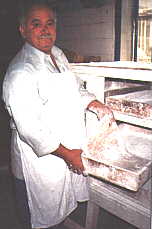Yeroskipos
used to be the home of sacred gardens. Now it produces divine sweets.
Chrissie Flint © reports

"Just east of Paphos is the village of
Yeroskipos, with its cluster of little basket and gift shops strung along the
roadside. It is a place well worth exploring with the picturesque five-domed
Byzantine church of Ayia Paraskevi and newly renovated Folk Art Museum.
The village's history stretches back to ancient times; its name, comes from the
classical Greek "Hieros Kipos" meaning "Sacred garden" it is
believed that it used to be an extensive area of beautiful gardens, filled with
fragrant flowers and pomegranate trees, dedicated to the goddess Aphrodite.
Pilgrims would rest in the gardens on their journey to the sacred temple at
Kouklia from the old harbour at Paphos.
|

|
|
Nearing
fruition...
loukoumia about to
be sliced.
|
Today
the gardens have long since gone. But the village is still
filled with a sweet sugary fragrance that is carried on ihe
air from a cluster of small buildings where the famous
"Cyprus Delights"—
a euphemism increasingly used since 1974 to describe what is
called Turkish delight in English—are made (in Greek, their
name, Loukoumia, has no geographical connotations).
Roadside stalls are piled high with brightly coloured boxes
of these delicious sweets and the owners stand in the shop
doorway and warmly invite you inside to watch the sweets
being made. Cyprus Delights have been made in the village
since 1895 and the little factories are all family concerns
thet have been handed down through the generations.
Each family closely guards their secret recipes!
|

|
|
Taking
shape...
Savvas rolls out his
Cyprus delights.
|
Inside
one of the shops Savvas can be seen cutting large slabs of
the cooled sweet mixture. He has been making sweets in the
same workshop started by his grandfather for over forty years
now, and he makes the sweets in the same way as he was taught
when he was a boy.
He
was happy to show me how to make the best loukoumia: Every
morning, three enormous copper cauldrons are filled with
water and the fires lit underneath them. Once the water has
boiled the sugar is added and the solution is boiled for an
hour, stirred continuously by an electric paddle. Next the
starch is added, and the mixture brought back to the boil,
for another five to six hours until it is smooth and shiny.
The mixture is allowed to cool for a while, before the
various flavours are added. There are twenty four to choose
from including cherry, lemon, almond and chocolate, as well
as the traditional rose flavour. The rose flavouring is made
by the villagers at this time of year by boiling handfuls of
fragrant rose petals and Collecting the condensed moisture.
After the flavourings have been carefully added, the mixture
is poured into large wooden trays to set.
About five hours later it is ready to be cut into squares,
liberally dusted with icing sugar and packed into small boxes
lined with greaseproof paper ready for selling.
Unlike many imitations the loukoumia made in Cyprus does not
contain gelatine and its high quality and smooth taste is
much appreciated by clients from all around the world who
regularly send orders to the shops.
|

|
|
Sweet
Almonds...
Savvas busy roasting sugared
almonds the traditional way.
|
As
well as making the loukoumia, the little workshops also
produce the best sugared almonds I have ever tasted—
not soft almonds coated in a hard, bright pink coating, but
freshly roasted, locally grown almonds with a creamy coloured
sugar coating that simply melts away.
The almond nuts are washed and Slowly roasted before being
put into large rottating copper cauldron, which is heated by
a flame. The nuts are basted with a sugar syrup until they
are evenly coated and then allowed to cool slightly before
the process is repeated. After several more coatings, the
almonds are allowed to cool thoroughly before being boxed
ready to be put on the shelves to sell.
As I left, Savvas mentioned with a smile that the loukoumia
and sugared almonds are best eaten within two months.
"No problem," I assured him!
















